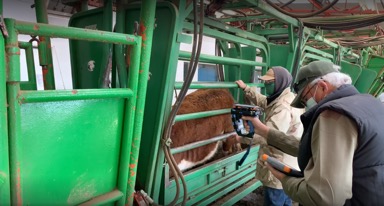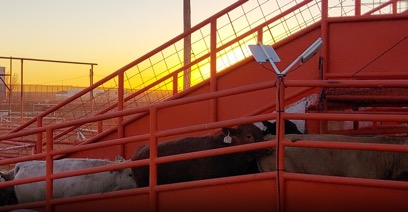Unparalleled Cattle Traceability
with UHF ID Technology
99-100% read rate at the unrestricted
speed of commerce

Use Case
- Cattle Movement Traceability Pilot
- MX-US Livestock Border Crossing at
Jeronimo, MX and Santa Teresa, NM - January 2022
Key Results
- UHF demonstrated 99-100% accuracy tracking cattle from
MX producers through the MX-US border port to the US feed yard - Cattle moved at the unrestricted speed of commerce with no facility modifications required
- UHF improved safety and reduced stress for both the livestock and handlers
- Proved the feasibility of implementing a UHF tag for the
SAGARPA and/or US Tuberculosis IDs
Abstract
Approximately 1.6 million head of cattle cross the border each year from Mexico to be finished and harvested in the United States. The USDA and SENASICA, with input from state officials and livestock associations in both countries, have developed biosecurity measures to mitigate entry of foreign diseases to the collective US herd. These measures include pre-border crossing preparation and testing, on-site border inspection of each animal and efforts to continue tracking each head of cattle as they move through the finishing and harvest locations in the US.
Historically, visual ID tags have been used for animal identification and to document their status and location in written records or spreadsheets. There is growing interest by multiple parties in transitioning to an effective electronic ID (EID) based tracking process. Border crossing demonstration projects utilizing low frequency EID have failed to achieve acceptable read rates without significantly altering group handling of cattle. Fort Supply Technologies’ pilot at the Jeronimo-Santa Teresa port clearly demonstrated the unparalleled performance of our ultra-high frequency (UHF) EID tags, autonomous readers, and cloud-based software. Fort Supply’s UHF inventory monitoring and movement tracking system (Asset Tracker) provided 99-100% accuracy for individual identification and movement monitoring at the unrestricted speed of commerce across multiple check points in the border crossing process.
Fort Supply Technologies will continue monitoring these cattle through the feed yard and harvest facilities. We are working collaboratively with Mexican livestock producers, state and federal officials, Five Rivers and JBS USA, all with a vested interest in the accurate, safe, and productive handling of cattle.

Mexican Side Of The Border
Mexican Side Of The Border

Tagged At Collection Facilities in Mexico
December 13-14, 2021


Received At Jeronimo Mexico Port
January 18 & 20, 2022


USDA Inspection Prior to Crossing
January 18 & 20, 2022
Tagged At Collection Facilities in Mexico | December 13-14, 2021

390 Read
390 Cattle
Three to four weeks before the cattle were delivered to the border for inspection and crossing, the initial tagging process occurred in Mexico resulting in three unique ID tags for each head of cattle – the SAGARPA ID (nested low frequency and visual tags that are the official Mexico ID tags), the USDA Tuberculosis ID (blue metal clip tag required by the USDA at the southern border), and a unique UHF tag ID (Fort Supply’s UHF strip tag). The three tag IDs were paired together in the Fort Supply Technologies’ Value Tracker application on a rugged tablet and then uploaded to our Fast HERD cloud-based software, along with appended data such as: animal sex, geolocation, date, and time stamp. 390 head of the cattle tagged at the collection facility were delivered to the Jeronimo Port for processing.
Received At Jeronimo Mexico Port |January 18 & 20, 2022

390 Read
393 Cattle
Each load of cattle was weighed in groups as they arrived at the Jeronimo Port in Mexico. All 390 head of cattle were autonomously identified in the weighing process. 100% (390 of 390) UHF ear tags were read on the scale at the speed of commerce. Fort Supply Technologies used autonomous stationary UHF readers and software (Asset Tracker) to identify and record the individual IDs. Fort Supply personnel were on hand to monitor the process, but no human involvement was required. The new data was automatically synced to the Fast HERD cloud updating the geolocation, date, and time stamp for each head of cattle.
USDA Inspection Prior to Crossing |January 18 & 20, 2022

390 Read
390 Tags
One to three days after arriving at the MX border corrals, the cattle were presented at the USDA inspection point prior to crossing. Fort Supply personnel were present and paralleled the USDA monitoring process using semi-autonomous hand-held UHF equipment and Value Tracker software. All 390 head of cattle were succcessfully identified at this station, resulting in a UHF read rate of 100% (390 of 390). Seven cattle were turned back by the USDA resulting in 386 head crossing the border. The new data was automatically synced to the Fast HERD cloud updating the geolocation, date, and time stamp for each head of cattle.

US Side Of The Border

Received At Santa Teresa, New Mexico Port
January 21, 2022


Loadout At Santa Teresa, New Mexico
January 21, 2022


Receiving At 5 Rivers, Hartley
January 22, 2022
Received At Santa Teresa, New Mexico Port |January 21, 2022

362 Read
386 Tags
After crossing the border, the cattle were again autonomously scanned on the scale at Santa Teresa, NM. The read rate of 93.8% (362 of 386) was an outlier. Fort Supply Technologies used only four antennas at this location for the temporary pilot installation. In a permanent installation, additional antennas would be deployed to cover and capture 100% of the livestock on the scale. The new data recorded at this location was automatically synced to the Fast HERD cloud updating the geolocation, date, and time stamp for each head of cattle.
Load-out At Santa Teresa, New Mexico | January 21, 2022

385 Read
386 Tags
Later that evening, 386 head of cattle were loaded onto four trucks with a successful autonomous read rate of 99.7% (385 of 386) at the true, unrestricted speed of commerce using a stationary UHF reader and Fort Supply Technologies software (Asset Tracker). Simulating what would be the function of a veterinarian on-site, Fort Supply personnel were on hand to monitor the process, document the truck information and notate the destination. This step facilitated tracking the specific cattle on each load. The new data was automatically synced to the Fast HERD cloud along with updating the geolocation, date, and time stamp for each head of cattle.
Receiving At 5 Rivers, Hartley | January 22, 2022

386 Read
386 Tags
All four loads were offloaded at the Five Rivers feed yard in Hartley, TX early the following morning. A Fort Supply stationary UHF reader and software (Asset Tracker) autonomously identified a read rate of 100% (386 of 386) with no Fort Supply or Hartley Feeders personnel present. Fort Supply Technologies’ pilot demonstrated accurate and autonomous identification, tracking, and management through all checkpoints while minimizing stress on the cattle and providing unrestricted speed of commerce capability. The geolocation data for each animal, including date and time stamps, demonstrates that Fort Supply’s UHF solutions can be used to accurately track individual animal and group movements.
This UHF border traceability pilot project is still in process. The cattle will continue to be monitored at the feed yard and when they are moved from the feed yard to the processing plant later this year. Fort Supply Technologies will update this project recap at that time. Representatives from the USDA, Texas Cattle Feeders Association, and Corral Quemado were onsite at the border port observing several steps of the traceability pilot process.
Value Tracker App – Mobile Data Capture Made Easy
One-Touch Connectivity | Reduces Human Error | Sync’s to FST Cloud.



Fast Herd – Enables Data Access, Analysis, and Secure Data Sharing
Data Management, Movement Tracking, and More on all Devices.

Fast HERD
- Cloud-Based Data Platform
- Permission-Based 3rd
Party Data Sharing
- User Interface to All Data
or Restricted Access on
- Any Web-Enabled Devices
The Fort Supply Technologies team is here to help
Schedule a time to talk about your operation & needs
